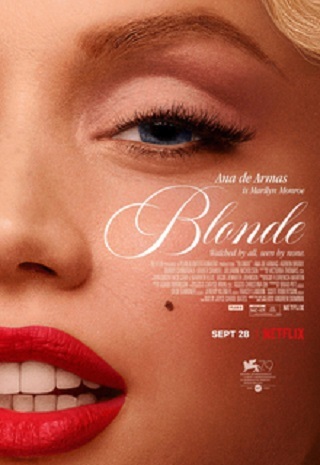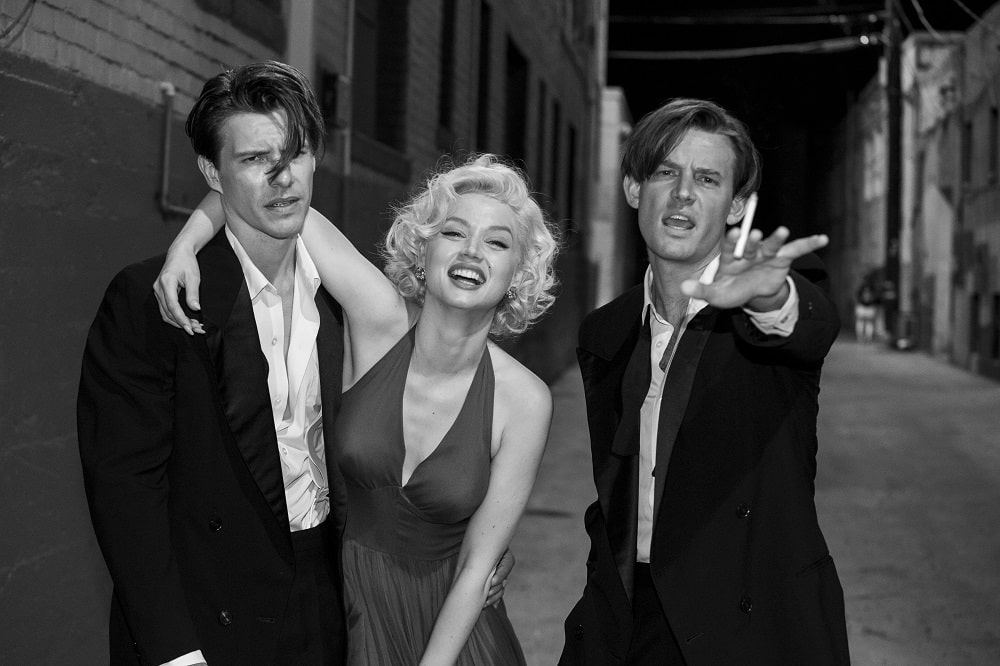Entering Andrew Dominik’s “Blonde,” the tapestry of the film unfolds against the backdrop of Los Angeles in 1933, a canvas painted with the raw hues of a young Norma Jeane Morstensen’s existence. Lily Fisher portrays her with a haunting vulnerability, a child grappling with the weight of the world as she navigates the harrowing contours of physical and emotional abuse. This torment is inflicted upon her by her own mother, Gladys, a portrayal made heartbreakingly poignant by Julianne Nicholson’s portrayal, her fractured psyche tragically succumbing to the grip of schizophrenia. The result: institutionalization for Gladys, and for Norma Jeane, a cruel shuffle between orphanages.
This initial chapter, a foray into the magical realist realm, captures the lens of a wounded child’s gaze, unveiling an attempt to fathom the unfathomable. This trauma, an indelible scar etched onto the canvas of her soul, is positioned as the crucible that molds the young girl into the enigmatic Marilyn Monroe – an icon whose private yearnings are anchored in a thirst for love and familial bonds.
However, this overture is a solitary note that gently strays from the rest of the composition. The film, with a runtime nearly three hours long, cascades through scenes that read like a ceaseless procession of Monroe’s exploitation at the hands of brutal, lustful men. “Blonde” draws from Monroe’s enigmatic life, of course, but it carves its artistic coordinates from Joyce Carol Oates’s biographical fiction novel of the same name. This literary predecessor unspools a labyrinthine narrative that meticulously paints Monroe as a canvas of suffering, each brushstroke illustrating the harrowing agony of a star who battles both physical and emotional abuse.
Andrew Dominik’s adaptation adorns this foundation with a visual allure that verges on the hypnotic. The screen flirts with impressionistic strokes, deliberately blurring the periphery around Monroe. In these moments, we are ensnared within her psyche, bearing witness as she embarks on feverish flights, escaping the shadow of her stardom, and yearning to rediscover the essence of the real Norma Jeane, buried deep within her own being. A deft choreography of tracking shots conceals the seam where reality stitches into dreams – a world of Freudian landscapes, a realm where nightmarish echoes tease her with visions of the love she craves, parents who cherish, and a brood of her own creation.
As a cinematic endeavor, “Blonde” transcends mere storytelling. It weaves a ravishing tapestry that melds form and content, an intricate dance where the cinematic brush strokes illuminate the canvas. The poignant narrative threads are caressed by the careful arrangement of shots, each frame resonating with a profound emotional undertone. Here, the ethereal meets the corporeal, an exploration of a mythic figure’s psyche that channels a sense of enchantment and enigma.
In Dominik’s “Blonde,” the narrative functions as a window into a fractured soul, while the visual language serves as a prism, refracting the facets of pain, desire, and fleeting moments of escape. With each passing frame, the film’s resonant portrayal of Monroe’s suffering and longing is intertwined with its evocative visual language, fusing together to form a haunting symphony of artistry and emotion.

Wonderfully Portrayed, Carefully Compiled
The film opens with a shot that almost feels like an echo through time, a haunting reverberation that encapsulates the essence of Marilyn Monroe’s existence. The dazzling lights of a soundstage cascade upon her, reminiscent of the iconic scene from “The Seven-Year Itch,” where her skirt flirtatiously dances on an updraft from a subway grate. This enchanting moment, forever etched in the annals of cinematic history, morphs into a chilling reflection later on. The same interplay of light, this time emanating from an operating room lamp, cast its clinical radiance upon her groin. Here, doctors perform an abortion coerced by the ruthless decree of a studio magnate. The glamour and sexual allure of the former scene becomes a heart-wrenching violation of her agency over her own body. It’s a disconcerting juxtaposition, a visual echo that transforms from one form of exploitation to another, casting a somber shadow upon the corridors of her existence.
However, as the film progresses, these once-ingenious techniques gradually begin to dim in their resonance. What was once a poignant narrative device begins to fray, the evocative symbolism of visual distortions charting Monroe’s descent into a labyrinth of pill addiction eventually losing its potency. The once-illuminating mirror into her spiraling path towards oblivion becomes a cheap shorthand, bordering on trite clichés. The transition from glittering allure to gritty despair begins to feel like a shortcut that overlooks the intricacies of her journey. The film at times appears to treat her as a mere canvas for a director’s wild artistic flourishes, rather than delving into her multifaceted persona.
On a different note, the cinematography, under the deft eye of Chayse Irvin, unveils a realm of homage to the golden age of Hollywood’s visual artistry. The scenes, rendered in monochrome, echo the high-contrast aesthetics that defined the realm of film noir, each frame adorned with the shades of shadow and light that evoke a sense of mystery and suspense. It’s a nod to the classics, a dance with the past that nods to the cinematic legacy of yesteryears.
Also Read: Amsterdam – Autumn’s Most Star-Studded Film
Furthering this tribute, the film occasionally conjures a sense of uncanny magic. CGI subtly weaves a tapestry of backgrounds reminiscent of rear-projection techniques employed in old films, an effect that awakens the nostalgia of viewing classics. These masterful recreations immerse us in an uncanny valley, where the boundary between reality and artifice begins to blur, just as it did in the age of vintage cinema. Moreover, color features and theatrical trailers from Monroe’s oeuvre are resurrected with digital wizardry. The hues, pulsing reds and creamy eggshell tones, mirror the aesthetic of old Technicolor, a cinematic dance that gracefully embraces the echoes of time.
As “Blonde” marches forward in its artistic journey, these intertwining threads – the visual metaphors and the cinematographic homage – weave a tapestry that occasionally dances on the fine line between resonance and ostentation. Yet, even as certain aspects of the film’s language might falter, the echoes of the past, the luminous allure of cinema’s golden age, and the vivid, complex woman at the center of it all, unfurl a narrative that beckons us into the enigmatic heart of Marilyn Monroe’s world.

“Blonde” Teeters on a Paradoxical Edge of Feminism
It’s intriguing to notice how Andrew Dominik’s “Blonde” harmonizes contemporary storytelling techniques with the nostalgic aesthetics of celluloid history. In this orchestrated fusion, though, it’s curious that the very films that constitute Marilyn Monroe’s cinematic legacy receive only fleeting glances. The fabric of “Blonde” is woven with moments that portray Monroe’s struggle for artistic recognition – an incessant endeavor to transcend her iconic image and delve into roles that resonate with depth. These instances unfurl as she immerses herself in the Actors Studio, drawing parallels between her characters and literary giants like Dostoevsky. Yet, she’s met with the condescending chuckles of men who seem incapable of fathoming her intellectual pursuits. The male figures, purposefully nameless and rendered almost interchangeable, project a dismissive tenor, their voices embodying a singular misogynistic resonance. This pointed aversion to distinctly individualizing them mirrors the film’s intention to strip them of their distinct identities, as if seeking to mirror the way they, in turn, attempt to erase her complexity.
The film’s thematic intention is unmistakable – an attempt to dissect and expose the latent sexism that pervaded the industry during Monroe’s era. However, in this pursuit, “Blonde” inadvertently strips these men of nuance, rendering them as mere vessels of abuse. This choice, while underscoring a larger narrative thread, unintentionally oversimplifies Monroe herself. The complexity of her character is flattened into a portrayal that’s both infantile and overly sexualized. This duality is starkly evident in de Armas’s nude scenes, shot in a manner that conjures a strangely unsettling contrast – an embodiment of both childlike naivety and a coquettish allure, an odd juxtaposition reminiscent of a child’s innocent playfulness.
The intersection between Monroe’s narrative and Bobby Cannavale’s character, a stand-in for Joe DiMaggio, introduces a narrative layer that unveils the complex dynamics of her relationships. DiMaggio offers a vision of rescue, promising to extricate her from the tumultuous life of a starlet. The film rightly depicts this gesture as patronizing, a reflection of the era’s patriarchal attitudes. However, there’s a subtle yet profound parallel drawn between DiMaggio’s posture and Dominik’s narrative choices. The film, perhaps inadvertently, dismisses Monroe’s calculated image management and her artistic aspirations in favor of a portrayal that, at times, renders her as a victimized pawn rather than a three-dimensional woman.
In essence, “Blonde” teeters on a paradoxical edge of feminism – one that yearns to liberate while inadvertently exacerbating victimization. This treatment often mirrors the very men it critiques, presenting a reductive view of Monroe in its endeavor to showcase her resilience and redemption. It’s an unsettling dichotomy wherein the film seems to “save” her by embellishing her suffering, potentially diluting the very essence of her agency.
In scrutinizing “Blonde,” a parallel between Dominik’s approach and the very patriarchal attitudes that Monroe grappled with emerges. The film, while aiming to amplify her voice, inadvertently perpetuates a narrative that echoes the very attitudes it dissects. In this reflection, one is left pondering the intricate nature of intent and outcome, as both the filmmaker and the era’s men struggle to genuinely understand and honor Monroe’s complexity. It’s an intricate tapestry of intentions and consequences that swirls, much like the whirlwind that enveloped Marilyn Monroe herself.
